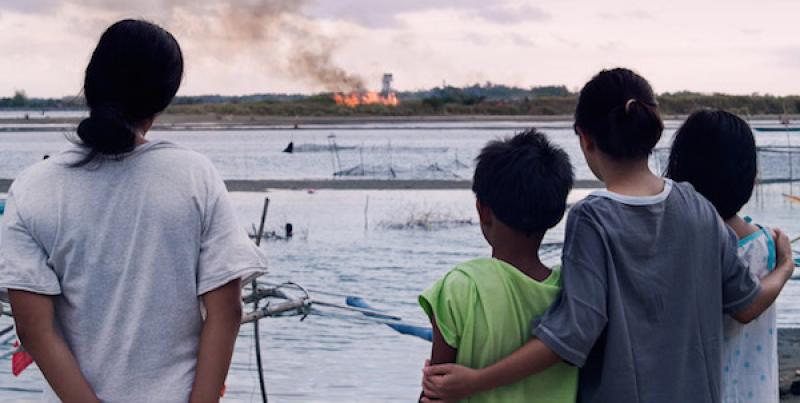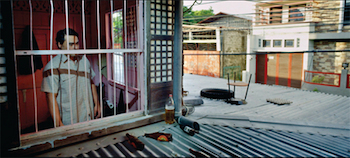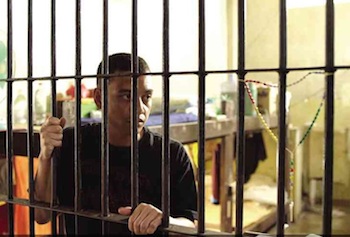Norte, the End of History | reviews, news & interviews
Norte, the End of History
Norte, the End of History
Lav Diaz's four-hour masterpiece transposes 'Crime and Punishment' to the Philippines

In the opening scene of Lav Diaz’s Norte, the End of History, the cash-strapped Fabian (Sid Lucero), a law school’s star student until he dropped out, sits in a trendy café pontificating to his friends about the absence of truth and meaning in the Philippines of the 21st century.
Unconsciously motivated by self-loathing, the result of having been neglected by his parents in childhood, Fabian has himself developed a fascist philosophy that sanctions the killing of the bad elements in society. Initially, his intellectual argument seems to be the hot air of a malcontent, a trivial man who hurls his cell phone into a river and sleeps with his best friend’s girlfriend. Then, one night, incensed by the spiteful treatment of a fellow client by his odious moneylender, Magda, he stabs her and her innocent teenaged daughter to death. Having made his existential choice, he buries the loot and leaves town. (Sid Lucero as Fabian, pictured below, in a prison of his own making.)
 Diaz also introduces the bootleg DVD peddler Joaquin (Archie Alemain) and his wife Eliza (Angeli Bayani), whose hopes of raising enough money to open a diner have been crushed by Joaquin’s temporary crippling in an accident. Just prior to the murders, Joaquin superficially attacks Magda for refusing to relinquish an heirloom ring Eliza pawned to her. He is wrongly arrested for the homicides and sentenced to life imprisonment without parole. Eventually, he is transferred to a penitentiary too far away for Eliza to visit him. Their faith in his being pardoned is ill founded.
Diaz also introduces the bootleg DVD peddler Joaquin (Archie Alemain) and his wife Eliza (Angeli Bayani), whose hopes of raising enough money to open a diner have been crushed by Joaquin’s temporary crippling in an accident. Just prior to the murders, Joaquin superficially attacks Magda for refusing to relinquish an heirloom ring Eliza pawned to her. He is wrongly arrested for the homicides and sentenced to life imprisonment without parole. Eventually, he is transferred to a penitentiary too far away for Eliza to visit him. Their faith in his being pardoned is ill founded.
The Philippine New Wave’s poetic minimalist master, Diaz unfolded his 2004 Evolution of a Filipino Family over nearly 11 hours in one cut. The more accessible Norte clocks in at four hours 10 minutes. Filmed in colour by a director who traditionally favours black-and-white, it is built on long, languorous, often wordless takes featuring delicate camera movements or static setups. Undisturbed by music, it is a semi-"slow cinema" opus that enables the analysis of the characters’ emotions within the frame and over the long haul.
Joaquin inherits Raskolnikov's toothacheJoaquin (Archie Alemain, pictured below) tends to a vulnerable cell mate after he is beaten by a sadistic inmate, and also the thug when he falls ill. He emerges as a secular martyr, suffering on behalf of the Filipino peasant class subjected to the political evil that is allegorically embodied in the bourgeois Fabian. Failing to assuage his guilt within a Catholic cult, Fabian declines spiritually and mentally. He rapes his loving sister, a wealthy and religiously devout farmer, and then commits another atrocity, but, like Marcos, he doesn’t pay materially for his crimes. The saintly Eliza’s protracted sufferings – she slaves as a vegetable vendor to provide for her two children and her sister – align her with the bleeding woman Fabian dispassionately observes dying in the street after the first scene. This symbolic anonymous victim prophesizes the tragedy that befalls one of the main characters at the end.
 Diaz punctuates the narrative with bucolic images of plantations and subjective Helicam shots of the country’s squalid beach shanties. These are comparable to the tracking shot of underwater detritus in Stalker (1978), directed by Andrei Tarkovsky, the Russian master who most influenced Diaz.
Diaz punctuates the narrative with bucolic images of plantations and subjective Helicam shots of the country’s squalid beach shanties. These are comparable to the tracking shot of underwater detritus in Stalker (1978), directed by Andrei Tarkovsky, the Russian master who most influenced Diaz.
The son of a movie-addict father, Diaz was born on 30 December, 1958 – the 62nd anniversary of the day Rizal was shot by a Spanish Army firing squad – and dubiously named for Lavrentiy Beria, Stalin’s monstrous NKVD chief and Gulag administrator. A greater legacy of his father’s Russophilia is Diaz’s passion for Fyodor Dostoevesky, whose philosophical investigations of evil and redemption inform the director's films. Versions of Crime and Punishment’s Raskolnikov appeared in The Criminal of Barrio Concepcion, Diaz’s 1998 feature debut, and in his 2002 Jesus Revolutionary; characters from The Idiot and The Brothers Karamazov have also wandered into his pictures.
A former student who considers himself above morality and thus licensed to kill, Fabian is another Raskolnikov, while Magda and her daughter stand in for Raskolnikov’s victims, the usurer Alyonya Ivanovna and her half sister, Lizaveta. Diaz, however, transposed both Raskolnikov’s need to confess (to Sonia) and the house painter Nikolai Dementiev’s self-sacrificial admission of guilt to Joaquin, who passively takes the rap for Fabian. Joaquin also inherits Raskolnikov’s toothache and is nicknamed “Rotten Tooth” in prison. Since there is something perpetually rotten in the Philippines, Joaquin, unlike Raskolinikov in Siberia, experiences no “gradual regeneration” but, rather, floats off into the ether, beyond time, history, and existence. As for the unredeemed Fabian, he floats off somewhere else.
Overleaf, watch the trailer for Norte, the End of History
The future of Arts Journalism
You can stop theartsdesk.com closing!
We urgently need financing to survive. Our fundraising drive has thus far raised £49,000 but we need to reach £100,000 or we will be forced to close. Please contribute here: https://gofund.me/c3f6033d
And if you can forward this information to anyone who might assist, we’d be grateful.

Subscribe to theartsdesk.com
Thank you for continuing to read our work on theartsdesk.com. For unlimited access to every article in its entirety, including our archive of more than 15,000 pieces, we're asking for £5 per month or £40 per year. We feel it's a very good deal, and hope you do too.
To take a subscription now simply click here.
And if you're looking for that extra gift for a friend or family member, why not treat them to a theartsdesk.com gift subscription?
more Film
 Robert Redford (1936-2025)
The star was more admired within the screen trade than by the critics
Robert Redford (1936-2025)
The star was more admired within the screen trade than by the critics
 Blu-ray: The Sons of Great Bear
DEFA's first 'Red Western': a revisionist take on colonial expansion
Blu-ray: The Sons of Great Bear
DEFA's first 'Red Western': a revisionist take on colonial expansion
 Spinal Tap II: The End Continues review - comedy rock band fails to revive past glories
Belated satirical sequel runs out of gas
Spinal Tap II: The End Continues review - comedy rock band fails to revive past glories
Belated satirical sequel runs out of gas
 Downton Abbey: The Grand Finale review - an attemptedly elegiac final chapter haunted by its past
Noel Coward is a welcome visitor to the insular world of the hit series
Downton Abbey: The Grand Finale review - an attemptedly elegiac final chapter haunted by its past
Noel Coward is a welcome visitor to the insular world of the hit series
 Islands review - sunshine noir serves an ace
Sam Riley is the holiday resort tennis pro in over his head
Islands review - sunshine noir serves an ace
Sam Riley is the holiday resort tennis pro in over his head
 theartsdesk Q&A: actor Sam Riley on playing a washed-up loner in the thriller 'Islands'
The actor discusses his love of self-destructive characters and the problem with fame
theartsdesk Q&A: actor Sam Riley on playing a washed-up loner in the thriller 'Islands'
The actor discusses his love of self-destructive characters and the problem with fame
 Honey Don’t! review - film noir in the bright sun
A Coen brother with a blood-simple gumshoe caper
Honey Don’t! review - film noir in the bright sun
A Coen brother with a blood-simple gumshoe caper
 The Courageous review - Ophélia Kolb excels as a single mother on the edge
Jasmin Gordon's directorial debut features strong performances but leaves too much unexplained
The Courageous review - Ophélia Kolb excels as a single mother on the edge
Jasmin Gordon's directorial debut features strong performances but leaves too much unexplained
 Blu-ray: The Graduate
Post #MeToo, can Mike Nichols' second feature still lay claim to Classic Film status?
Blu-ray: The Graduate
Post #MeToo, can Mike Nichols' second feature still lay claim to Classic Film status?
 Little Trouble Girls review - masterful debut breathes new life into a girl's sexual awakening
Urska Dukic's study of a confused Catholic teenager is exquisitely realised
Little Trouble Girls review - masterful debut breathes new life into a girl's sexual awakening
Urska Dukic's study of a confused Catholic teenager is exquisitely realised
 Young Mothers review - the Dardennes explore teenage motherhood in compelling drama
Life after birth: five young mothers in Liège struggle to provide for their babies
Young Mothers review - the Dardennes explore teenage motherhood in compelling drama
Life after birth: five young mothers in Liège struggle to provide for their babies
 Blu-ray: Finis Terrae
Bleak but compelling semi-documentary, filmed on location in Brittany
Blu-ray: Finis Terrae
Bleak but compelling semi-documentary, filmed on location in Brittany

Add comment